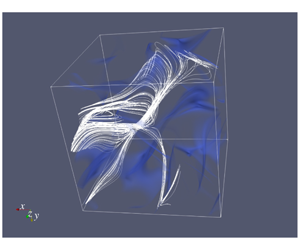Article contents
Maximum amplification of enstrophy in three-dimensional Navier–Stokes flows
Published online by Cambridge University Press: 23 April 2020
Abstract

This investigation concerns a systematic search for potentially singular behaviour in three-dimensional (3-D) Navier–Stokes flows. Enstrophy serves as a convenient indicator of the regularity of solutions to the Navier Stokes system – as long as this quantity remains finite, the solutions are guaranteed to be smooth and satisfy the equations in the classical (pointwise) sense. However, there are no estimates available with finite a priori bounds on the growth of enstrophy and, hence, the regularity problem for the 3-D Navier–Stokes system remains open. In order to quantify the maximum possible growth of enstrophy, we consider a family of optimization problems in which initial conditions with prescribed enstrophy  ${\mathcal{E}}_{0}$ are sought such that the enstrophy in the resulting Navier–Stokes flow is maximized at some time
${\mathcal{E}}_{0}$ are sought such that the enstrophy in the resulting Navier–Stokes flow is maximized at some time  $T$. Such problems are solved computationally using a large-scale adjoint-based gradient approach derived in the continuous setting. By solving these problems for a broad range of values of
$T$. Such problems are solved computationally using a large-scale adjoint-based gradient approach derived in the continuous setting. By solving these problems for a broad range of values of  ${\mathcal{E}}_{0}$ and
${\mathcal{E}}_{0}$ and  $T$, we demonstrate that the maximum growth of enstrophy is in fact finite and scales in proportion to
$T$, we demonstrate that the maximum growth of enstrophy is in fact finite and scales in proportion to  ${\mathcal{E}}_{0}^{3/2}$ as
${\mathcal{E}}_{0}^{3/2}$ as  ${\mathcal{E}}_{0}$ becomes large. Thus, in such a worst-case scenario the enstrophy still remains bounded for all times and there is no evidence for formation of singularity in finite time. We also analyse properties of the Navier–Stokes flows leading to the extreme enstrophy values and show that this behaviour is realized by a series of vortex reconnection events.
${\mathcal{E}}_{0}$ becomes large. Thus, in such a worst-case scenario the enstrophy still remains bounded for all times and there is no evidence for formation of singularity in finite time. We also analyse properties of the Navier–Stokes flows leading to the extreme enstrophy values and show that this behaviour is realized by a series of vortex reconnection events.
JFM classification
- Type
- JFM Papers
- Information
- Copyright
- © The Author(s), 2020. Published by Cambridge University Press
References
Kang et al. supplementary movie 1
Time evolution of the vorticity components (blue) $\widetilde{\omega}_1$, (red) \widetilde{\omega}_2$ and (green) $\widetilde{\omega}_3$ in the solution of the Navier-Stokes system (2.1) with the optimal asymmetric initial condition $\widetilde{\mathbf{u}}_{0;\mathcal{E}_0,T}$ obtained by solving the finite-time optimization problem 3,1 for the initial enstrophy $\mathcal{E}_0 = 500$ and $\widetilde{T}_{\mathcal{E}_0} = 0.17$, cf. figure 13. The animation covers the time interval $[0,widetilde{T}_{\mathcal{E}_0}]$.
Kang et al. supplementary movie 2
Time evolution of the vorticity components (blue) $\widetilde{\omega}_1$, (red) $\widetilde{\omega}_2$ and (green) $\widetilde{\omega}_3$ in the solution of the Navier-Stokes system (2.1) with the optimal asymmetric initial condition $\widetilde{\mathbf{u}}_{0;\mathcal{E}_0,T}$ obtained by solving the finite-time optimization problem 3,1 for the initial enstrophy $\mathcal{E}_0 = 300$ and $\widetilde{T}_{\mathcal{E}_0} = 0.21$. The animation covers the time interval $[0,widetilde{T}_{\mathcal{E}_0}]$.
Kang et al. supplementary movie 3
Time evolution of the vorticity components (blue) $\widetilde{\omega}_1$, (red) $\widetilde{\omega}_2$ and (green) $\widetilde{\omega}_3$ in the solution of the Navier-Stokes system (2.1) with the optimal asymmetric initial condition $\widetilde{\mathbf{u}}_{0;\mathcal{E}_0,T}$ obtained by solving the finite-time optimization problem 3,1 for the initial enstrophy $\mathcal{E}_0 = 1000$ and $\widetilde{T}_{\mathcal{E}_0} = 0.12$. The animation covers the time interval $[0,widetilde{T}_{\mathcal{E}_0}]$.
- 10
- Cited by




